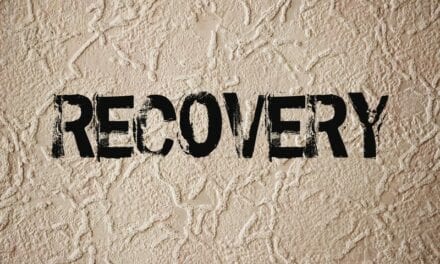A select group of managers from rehab facilities across the nation offer Rehab Management an insider’s perspective about the capital equipment purchases ($500 or more) their facilities are making to serve distinct inpatient and outpatient populations. While these facilities may seem to share broad similarities, upon closer examination it becomes clear that each pursues a strategy to bring aboard technologies that offer competitive advantages and a foundation that helps them shape a distinctive standard of care.
Prepared for Pediatrics
By Todd S. Danos, MBA, LOTR, FACHE, Director of Rehabilitation Services, Children’s Hospital New Orleans
Children’s Hospital formed Louisiana Children’s Medical Center when it aligned with Touro Infirmary in 2009. Now called LCMC Health, it has become a local, community-minded healthcare leader that operates Children’s Hospital, Touro, New Orleans East Hospital, University Medical Center and West Jefferson Medical Center. With more than 40 pediatric specialties and more than 400 physicians, it is the only full-service hospital exclusively for children in Louisiana and the Gulf South.
Critical care is provided in the hospital’s 36-bed Neonatal Intensive Care Unit (NICU), 24-bed Pediatric Intensive Care Unit (PICU), and 20-bed Cardiac Intensive Care Unit (CICU), the only one dedicated entirely to the care of cardiac patients from birth to adulthood.
The hospital’s Jack M. Weiss Emergency Care Center is staffed around the clock by board-certified pediatricians with the availability of a full range of pediatric specialists. The emergency department is supported by a nursing staff specially trained to handle pediatric emergencies.
Rehabbing the Youngest Patients
The rehab equipment needs of a children’s facility and a general hospital are both very similar. Obviously, there is a greater need for a wide range of sizes, given the age range treated by a children’s hospital. There is also a great need for sensory integration-related equipment, as this is very prevalent. Likewise, a facility devoted to providing care to children incorporates more options for devices such as specialized walkers, seating and positioning equipment, and equipment to address infant issues such as feeding and positioning. Overall, however, the main rehabilitation equipment is much the same as a rehabilitation unit for adults.
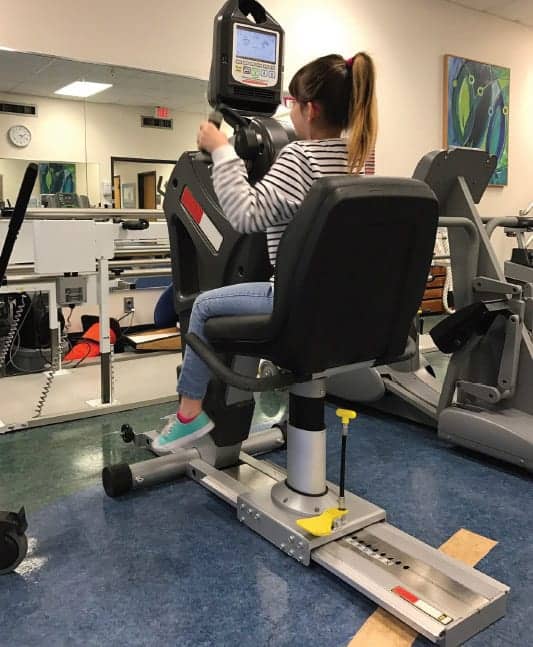
Pediatric patient at Children’s Hospital, New Orleans, performs
upper body resistance exercises to treat an elbow issue.
Capital Equipment Essentials
Children’s Hospital is a 247-bed facility that serves children from birth to 21 years of age with a range of healthcare services. The facility has a great need for child-friendly equipment, sizes, and options with patients who have not yet entered their teenage years. In today’s environment, advanced technology increasingly comes into play. This includes computerized gaming that can be used in treatment as well as balance equipment, FES bikes, and pediatric-size ADL equipment. There is also a need to incorporate tablet computing devices and other products that enable apps to be accessed for use in treatment. As capital equipment goes those are some of the essentials.
Purchasing and the Not-for-Profit
The status of Children’s Hospital as a not-for-profit medical center does not affect the ability to get needed capital equipment. Rehab was an integral part of the Children’s Hospital beginnings, and the organization continues to be generous to this department. The therapy staff and director of rehab services stay current with the market and what is needed to stay ahead of competition. There is always a need to focus on the latest technology and as well as what benefits patients and sets the facility apart.
Budget and Space
Budget and space both have an influence on future decisions we would make about purchasing technologies on a “wish list.” Space is always at a premium in hospitals. Fortunately, Children’s is embarking on a major renovation project for the next 5 years, so there should be the opportunity to add space to the rehab area.
As with many healthcare facilities, this hospital routinely surveys the technology landscape for equipment that potentially could evolve some of its available treatment, thus creating an informal “wish list.” In looking at such a list, if prospective purchases can be planned out strategically, then budget does not play such a significant role. You cannot always get what you want immediately, but you get what you need, if planned well. Some of the equipment that would appear on that list include FES bikes, computerized balance equipment, and an integrated therapy system with interactive touchscreen. We would also want to increase the capacity for technology that uses neuromuscular electrical stimulation in the treatment of dysphagia as well as other speech and hearing equipment.
Todd S. Danos, MBA, LOTR, FACHE, is director of rehabilitation services at Children’s Hospital New Orleans. He is a licensed occupational therapist, has a Master’s in Business Administration degree, and is board certified in healthcare management as a Fellow with the American College of Healthcare Executives. He has 25 years of clinical experience in the field of rehabilitation and 19 years of experience at a leadership/management level in the pediatric and adult environments.
Inpatient and Outpatient Under One Roof
By Julie White, MS, PT, Clinic Manager, TherapyPlus Lincoln Campus, Lincoln, Neb, Madonna Therapy
Madonna TherapyPlus consists of three outpatient therapy clinics in the Lincoln, Neb, area. Recently, however, Madonna Rehabilitation Hospitals added another TherapyPlus outpatient clinic in Omaha, Neb, to coincide with the opening of a new inpatient rehabilitation hospital there.
Madonna TherapyPlus is a vital component in Madonna Rehabilitation Hospitals’ continuum of care. The Lincoln and Omaha campus clinics offer outpatient physical therapy, occupational therapy, speech therapy, neuropsychology, and recreation therapy to individuals with neurological and orthopedic conditions. In addition, there is a comprehensive Rehabilitation Day Program (RDP) focused on adult and pediatric patients with community re-entry skills that offers a more intense level of outpatient therapy. Approximately 27% of RDP patients come from Madonna’s inpatient level of care. TherapyPlus is located in the same building as the inpatient services and provides patients access to the same equipment as they move through the continuum of care.
TherapyPlus’ target population is comprehensive neurological patients, particularly those with acquired injuries. Our expertise focuses on four key program areas, including stroke, spinal cord injury, brain injury, and pediatrics. Additionally, TherapyPlus serves many patients with multiple sclerosis, Parkinson’s, amputations, etc.
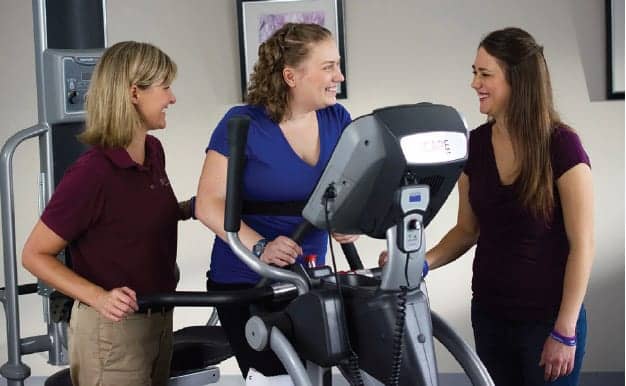
A motorized elliptical trainer is capital equipment that is helpful for a variety of patients recovering from a stroke, mild traumatic brain injury, or incomplete spinal cord injury.
Technology as an Adjunct Intervention
Capital equipment and technology pieces are part of the treatment regimen for many patients, but we also rely heavily on therapeutic exercise prescription and manual therapy techniques. Technology truly is an adjunct intervention that therapists can choose based on the patient presentation. TherapyPlus uses a variety of different capital equipment, including treadmills, a reactive balance system, body weight support treadmill, a motorized body weight-supported elliptical trainer, functional robotic gait therapy, robotic exoskeleton for integrated arm and hand rehabilitation, a touchscreen-based integrated therapy system, and robotic exoskeletons for lower extremities, among others.
A motorized elliptical trainer developed by Madonna’s Institute for Rehabilitation Science and Engineering is most helpful for a variety of patients recovering from a stroke to mild traumatic brain injury (TBI) to incomplete spinal cord injury. Functional electrical stimulation orthoses designed for use on upper and lower extremities are used frequently with stroke and spinal cord patients. TherapyPlus treats a high volume of patients who have sustained a mild TBI and find mechanical cervical traction to be beneficial in addressing cervical spine symptoms. Robotic devices can create less physical strain on staff, which is important to our focus on safe patient movement and handling.
Advanced Technologies for Appropriate Care
TherapyPlus brings in new technology to help patients more fully achieve their goals and to support specific program development. There are many advanced pieces of technology at the Lincoln and Omaha Campuses, including the body weight support treadmills and separate exoskeleton devices designed for lower extremities and upper extremities. These innovative technologies were purchased in conjunction with Madonna’s inpatient programs to provide therapists with additional treatment options. By offering a variety of technologies, therapists can select the right device for patients. An internal guide for what technology is appropriate for certain patient presentations was also developed.
While it is difficult to determine whether our successful patient outcomes are due to technology, many benefits have been noted from the use of advanced technologies. Patients can complete mass repetitions of tasks, such as walking, using the principle of neuroplasticity. They have improved activity tolerance and can achieve more with the assist provided by the equipment. Additionally, the patients use proper form during these mass repetitions (eg, not hyper-extending their knee or not fully shifting body weight). By using proper mechanics, these technologies help maintain joint integrity and assist in prevention of further injuries. The use of the technology also excites patients. They love trying equipment that is on the cutting edge. Even with the advanced technologies, therapists still use their skills in assessing and treating patients to help achieve optimal outcomes; technology is just one of the “tools in the toolbox.”
Julie White, MS, PT, is the outpatient physical therapy clinical supervisor for Madonna Rehabilitation Hospital’s Main Campus as well as program leader for the Amputation Program. She earned her Master’s of Science degree in physical therapy from the University of Indianapolis in 1998. She has experience in both inpatient and outpatient rehabilitation settings, treating a variety of diagnoses including persons with amputation, multiple trauma, total joint replacement, and general orthopedic injuries.
More than Medical
By Terrie Enis, PT, MSPT, Director of Rehabilitation Services, Emerson Hospital, Concord, Mass
In 2016 Emerson Hospital’s Center for Rehabilitative and Sports Therapies opened as a very important piece of a large puzzle when providing services for the Emerson community. The center supports a large portion of our medical staff in the care of their patients. We partner with surgical weight loss, the pain center, The Dr. Robert C. Cantu Concussion center, neurologists, orthopedics, endocrinologists, neurosurgery, and the Cancer center. Beyond the medical piece, we support athletic teams for baseline testing, concussion education, and treatment, if needed. Athletic assessments are also provided to identify potential injury risks and mitigate those risks with appropriate strength and conditioning programs. Emerson Hospital is committed to the community to provide the services needed to keep its population well, and the center is core to that mission.
Diversity Demands Technology
The patient population served by this facility is diverse. Its primary population has orthopedic diagnoses, sprains, strains, repairs, and joint replacements. Pediatric to geriatric patients are also served, as well as those affected by neurology, oncology, vestibular, pelvic health issues, and many other types of issues that interfere with daily living.
Handling this spectrum of patients calls for specific pieces of equipment that are “must haves.” Among these are: high/low tables, treadmills with incline and reverse, pulley systems from lat pulls to speed pulleys, leg press, bikes—upright and recumbent—as well as upper body ergometers. An abundance of open floor space was intentionally left into the center’s design to allow the therapists to be creative in designing treatment programs for their patients.
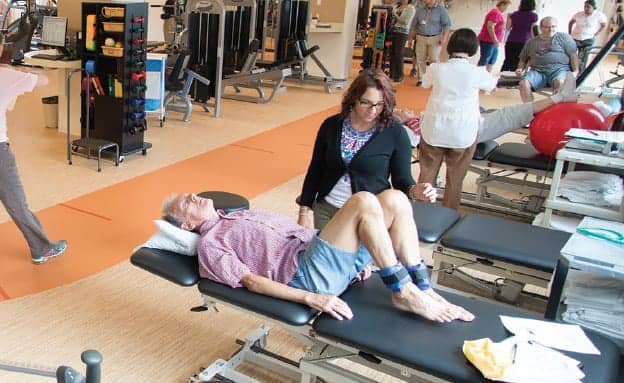
Therapists at Emerson Hospital’s Center for Rehabilitative and Sports Therapies using treatment tables with adjustable sections.
Investment in the Cutting Edge
Among the capital equipment that was purchased to open the center were certain devices that might be considered “cutting edge.” Within this category would be a visual motor and neuro-cognitive rehabilitation and sports training device as well as a treadmill that provides printed feedback to the therapist about step and stride length, weight-bearing status for each extremity, and single-leg stance time. Also in this category is a body weight-supported treadmill that enables the patient to walk independently either on the treadmill or in the gym with the correct weight-bearing and also eliminates the fear of falling.
Another cutting-edge piece of equipment used for many patients is the aquatic therapy pool. This is the only program in the suburbs west of Boston to feature an aquatic therapy pool with an underwater treadmill and video system that allows therapists to observe patients as they exercise. The pool is similar to those used by top athletes, including Boston Bruins and Boston Red Sox players.
While there are no advanced technologies on what might be described as the center’s “wish list,” there are certain large pieces of equipment that would be desirable, such as a squat rack and bench press. These would be used to continue to support athletes who want to avoid injury and improve their strength and endurance. However, this equipment would require additional space, which is something that we are always thinking about as we continue to expand services for the residents of the 25 towns this health system supports.
Terrie Enis, PT, MSPT, is director of rehabilitation, Emerson Hospital, Concord, Mass. She graduated from the University of Massachusetts, Lowell, with a Master’s degree in physical therapy and has 25 years of experience in the field of physical therapy. Enis was named Clinical Educator of the Year by the New England Consortium of Academic Coordinators of Clinical Education and is certified as a clinical instructor by the APTA.
Sports Medicine
By Brian J. Adams, PT, DPT, OCS, CSCS
A majority of the athletes treated at Adams Sports Medicine & Physical Therapy, Novi, Mich, participate in endurance events: cycling, running, triathlon. Likewise, the practice treats considerable numbers of CrossFit and high school athletes. The practice’s current clinical setting is less than typical: a rehabilitated old warehouse in an industrial area in the suburbs of Detroit. The office has excellent exposure, though it is not a typical medical space. It is an open, functional space with abundant natural light. It is flanked by a CrossFit box and an adjacent building is home to an indoor roller hockey league and indoor volleyball league. This creates a unique flow of athletes from the community.
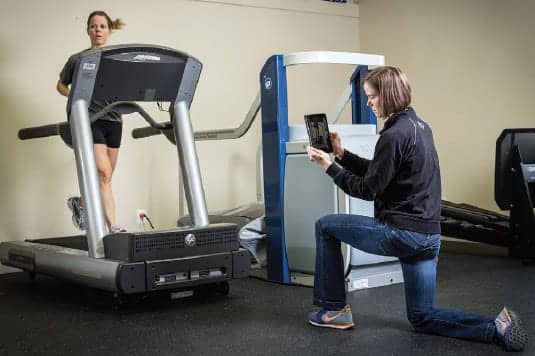
Treadmills are among the equipment that provide the best return on investment at the sports-centric Adams Sports Medicine & Physical Therapy, Novi, Mich.
Treating a Spectrum of Competitors
Due to the nature of the practice’s athlete population, it would be nearly impossible to perform the spectrum of treatment these individuals require without a few key pieces of equipment. Among these important technologies is a strong and reliable treadmill to conduct running gait analysis and training. Additionally, an antigravity treadmill is vital in helping transition running athletes back to full competition. For cyclists a resistance trainer is used for medical bike fit/analysis, along with an indoor cycle/trainer to conduct additional sizing and physiological testing, including heart rate/power output, blood lactate, and threshold testing. For the recovering athlete, compression boots are often used as well as a muscle stimulator. The rest of the functional space is outfitted with traditional resistance bands and physio-balls, along with balance pads and body blades. A cable cross system provides additional resistance during functional training. For conducting gait analysis, functional movement analysis, and medical bike fitting, a small tablet device with a high-speed camera pairs very well with current motion apps.
Best Value Technologies
Exercise cycles and treadmills offer the most “bang for the buck” to the practice’s population. They provide a safe and consistent platform for therapists to conduct gait training, running gait analysis, general warm-up activities, as well as functional training. The anti-gravity treadmill has transformed the lives of many would-be retired runners, allowing them to progress safely back from injury and run pain-free. Likewise, motion capture devices such as the iPad are a great resource to many clinicians across any physical therapy arena. Treatment tables, too, are essential capital equipment for any practice with the potential to offer years of service. Tables that have adjustable sections can provide added comfort and utility to the patient and therapist. Also, hi-lo tables that are motorized can provide a good degree of flexibility and strength, with some models able to accommodate bariatric patients.
Wish List
As the practice’s programs develop and more efficient ways to treat its current population emerge, several technologies have been identified that could help expand the practice:
• Upgrade to a custom-size cycle for improved bike fitting.
• Incorporating pressure sensors with running, cycling, and more specifically, with saddle sizing and customization with bike fitting.
• Although multiple modalities are used sparingly in the clinic (ultrasound, electric stimulation, hot packs, and ice packs), we continue to watch the industry develop technologies such as cold laser to help optimize soft tissue growth and regeneration.
One of the practice’s greatest investments is in itself and its staff. Ongoing continuing education and developing the team’s knowledgebase helps to retain some of the leaders in our industry as it pertains to physical therapy, rehabilitation, and the optimal treatment of endurance athletes. There are many emerging studies and concepts in regard to clinical practice, evidence-based practice, and functional outcomes, and the landscape for physical therapists and sports medicine specialists is diverse and ever-changing. The goal is to not only keep up but to continue to move forward. RM
Brian J. Adams, PT, DPT, OCS, CSCS, is a practicing physical therapist and owner at Adams Sports Medicine & Physical Therapy, P.C., Novi, Mich. He is a Certified BikeFit Pro/Instructor, USA Cycling Coach, and Elite level cyclist, focusing on the needs of the cyclist/triathlete. He routinely makes presentations about evaluation and treatment of the upper and lower extremities as they relate to endurance athletes. For more information, contact [email protected]om.




